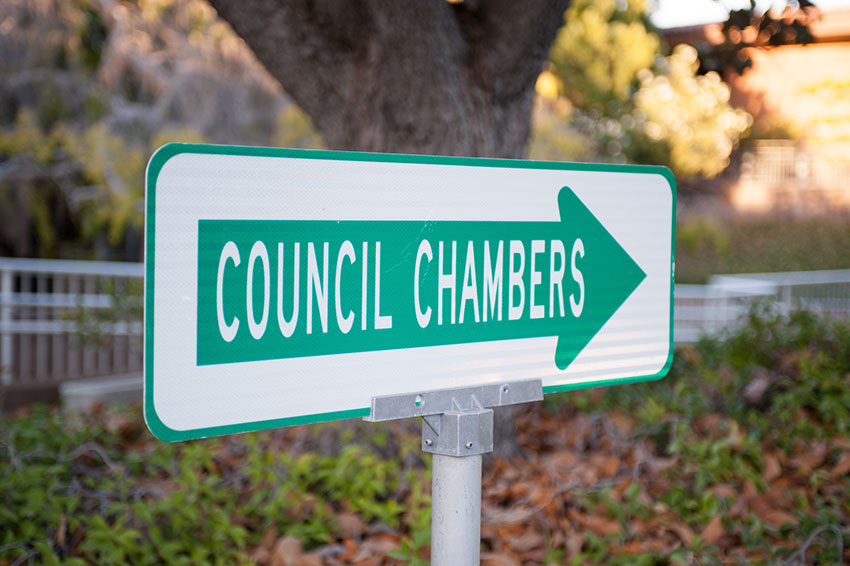Eliminating street parking along El Camino Real saw significant discussion during the last Santa Clara City Council meeting.
What began as a routine note-and-file item ballooned into a lengthy discussion Tuesday night. The topic returned on the consent calendar, an amalgamation of routine items voted on in a single motion, but was pulled for discussion.
Council Member Teresa O’Neill pulled the item, saying “there have been some letters” about the Council’s decision to eliminate parking along the El Camino corridor that she feared represented some “misunderstandings in the community.”
Because of conflicts of interest, Mayor Lisa Gillmor and Council Members Karen Hardy and Raj Chahal recused themselves from the discussion.
Howard Myers, a resident of the City, said the amount of times Council Members abstain has “gotten out of hand,” calling it “insane.” Voters elect Council Members precisely because they have interests similar to their constituents, he added.
“The only person who can vote is the person who doesn’t give a darn,” he said. “We need someone who has skin in the game.”
Regarding the El Camino Focus Plan, Andrew Crabtree, Director of Community Development, reiterated his presentation from February where the Council directed employees to pull the trigger on an option that would widen bike lanes and rid the corridor of street parking.
This effort aims to stage the City’s largest commercial thoroughfare as a pedestrian-friendly streetscape. Another alternative — which still eliminates street parking but also widens the median to accommodate trees — would also eliminate a lane for cars.
Many spoke about the need to increase safety for cyclists and pedestrians.
“People are being killed,” said Council Member Debi Davis. “They go to work, and they don’t come home.”
One speaker, Gabriela Landaveri, noted that on-street parking reduces visibility.
Concerns over safety along El Camino Real are not contained to Santa Clara, nor are they unfounded.
The Bikes and Pedestrians Commission recommended eliminating the street parking when the California Department of Transportation (Caltrans) repaves the road, which has already gotten underway and stretches into the summer.
Although the deadline for the El Camino Specific Plan is the end of June 2020, Crabtree said the Council should expect to see its completion by early 2020. Eliminating parking to make way for more landscaping and wider bike lanes will cost the City an addition $120,000 and delay the project roughly 3 months.
BART Extends to Santa Clara
By this time next year, the Valley Transit Authority (VTA) will apply for a federal grant. The grant will fund the remaining $1.35 billion for phase two of a Bay Area Rapid Transit (BART) line that would bring a station to Santa Clara.
During an informational report, Ron Golem, Deputy Director of Real Estate for VTA, and Jill Gibson, VTA Outreach Manager, told the Council VTA wants to build on its relationship with the City.
Golem called the BART extension a “once-in-a-century opportunity” that will facilitate a series of transit-oriented communities throughout the Bay Area.
The $5.5 billion project will add underground stations at Alum Rock/28th Street, San Jose Diridon and downtown San Jose in addition to the above-ground station adjacent to the existing CalTrain station in Santa Clara. By 2035, VTA estimates daily ridership at the Santa Clara station to be up to 7,800, according to a VTA factsheet.
Passenger service is scheduled to begin in 2026, according to VTA.
Council Befriends Korean City
The Council also approved naming Icheon City, Korea a Friendship City.
Icheon City, said Water Rossmann, the City’s Chief Operating Officer, shares some similarities with Santa Clara, namely that it too is a manufacturer of semiconductors and plays host to a university. The Cultural Commission and Rossmann recommended a three-year Friendship City status.
Being a Friendship City is the first step in becoming a Sister City. Santa Clara has three Sister Cities: Limerick, Ireland; Izumo, Japan; and Coimbra, Portugal.
Although the City has repeatedly put the kibosh on establishing a Koreatown in Santa Clara, members of the Council lauded Korean-owned businesses.
Vice Mayor Patricia Mahan said “they have contributed so much” while Mayor Lisa Gillmor said “they are part of us.”
“We feel a great love and connection, so this is real natural for us to take the next step,” Gillmor said.
“This is the beginning of a new era.”
Construction Bolsters City Coffers
Also on the consent calendar was February’s financial report. The report shows that the City’s total revenue has increased by 15.5 percent over the past year while spending has only increased 8.4 percent.
Notable among revenue was a 76 percent increase in permit revenue due to new construction.
The Council meets again April 30 in the Council Chambers at City Hall, 1500 Warburton Ave. in Santa Clara.
Editor’s Note: This article has been updated to clarify the BART information presented at the meeting.
